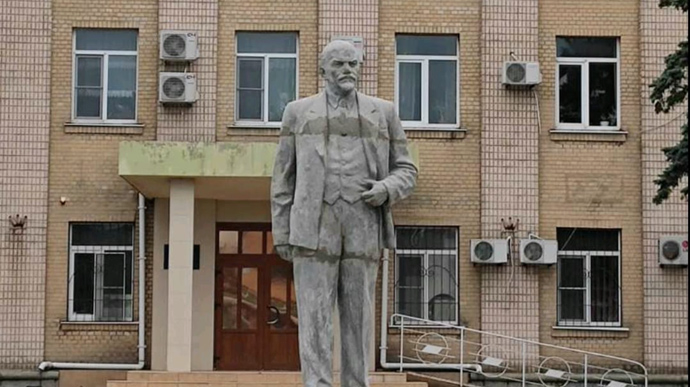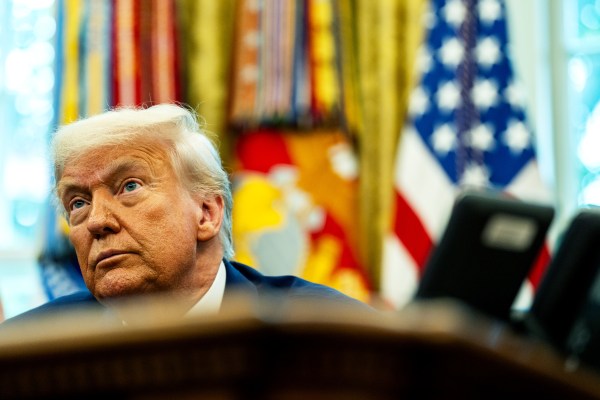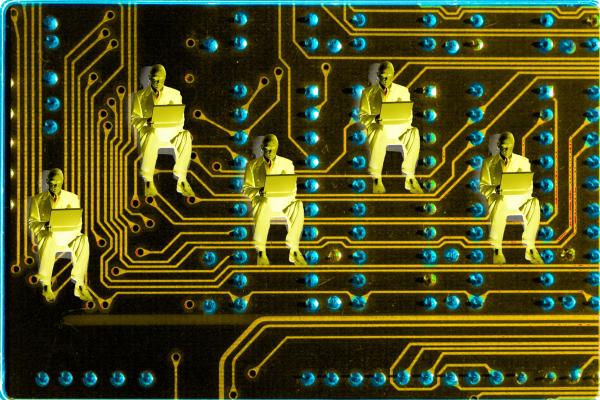A statue of Vladimir Lenin again stands in front of the municipal building in the Ukrainian town of Henichesk, in Kherson oblast, right over the border from Crimea. Based on available photos the Russian flag and some kind of Soviet flag were already flying above the municipal building. During the Maidan Revolution in early 2014 that led to the removal of pro-Russian President Viktor Yanukovych, activists pulled down Lenin statues all across Ukraine. The original Lenin statue in Henichesk was not brought down during this time. It was removed by city officials in 2015 after Ukraine passed a decommunization law banning Soviet symbols.
Henichesk Mayor Alexander Tulupov told a reporter at the time that 90 percent of the population of the town “reacted normally to the demolition of the monument,” but that some residents were indignant. He also emphasized: “We did not allow this monument to be thrown away, we left it for history. Today we have it in safekeeping in one of the utility companies.”
Now a Lenin statue has reappeared, but it is not the same one as the one taken down in 2015. They didn’t just take the old one out of a warehouse and pop it back into place; somebody expended some effort and found a different one (maybe the old one was too big or could not be located).
This might strike some as a bit strange, as Vladimir Putin has stated that Lenin’s revolution betrayed the interests of the Russian nation. In 2016 he directly condemned Lenin as an oppressor who had killed priests and the czar and for having placed a “time bomb” under the Russian state by allowing internal “ethnic” regions in the Soviet Empire. In his pre-war speech on February 21, Putin specifically invoked Lenin as the ultimate villain behind Ukraine’s existence:
“Ukraine was entirely created by Russia or, to be more precise, by Bolshevik, Communist Russia. … Lenin and his associates did it in a way that was extremely harsh on Russia—by separating, severing what is historically Russian land. Nobody asked the millions of people living there what they thought. … When it comes to the historical destiny of Russia and its peoples, Lenin’s principles of state development were not just a mistake; they were worse than a mistake, as the saying goes. This became patently clear after the dissolution of the Soviet Union in 1991.”
Given all these negative comments about Lenin, why is he reappearing after Putin conquered Henichesk? The answer likely lies in power dynamics and nostalgia, rather than any ideological commitment by Putin’s forces.
A few years ago, while I was working as an election monitor in southern Ukraine, I stopped at a polling station located within a big Soviet-built “palace of culture” in a rural settlement. When it had been built in the early 1950s it was probably a very commanding architectural statement in this country market town that was in the process of being transformed into a large collective farm. There was an indoor Soviet war memorial at the far end of the building’s high-ceilinged entrance hall. It was a large recess with two large square columns. The columns and the rest of the memorial were covered in carved wooden panels. Some of the panels were decorative, especially on the columns and around the sides of the memorial. The panels on the walls behind the columns had rows and rows of black and white photos of local WWII veterans. While I was waiting in the entrance hall for a colleague I went into the memorial to check it out, and it was only as I turned to leave that I saw Joseph Stalin. His image had no doubt been part of the original memorial, probably holding pride of place in the front.
Evidently, at some point someone had switched out the wooden panel with his image and switched it with a panel that had been in back of one of the memorial’s two columns. Now you could see him only if you went into the memorial and then turned and looked up at a certain angle, like the secret image of a god hidden in the nook of a pagan temple, known only to the high priests. This image of Stalin had not just survived the decommunization laws in modern-day Ukraine, it had survived destalinization in the USSR! (This was the period after Soviet leader Nikita Khrushchev’s 1956 “Secret Speech” that saw the dismantling of the personality cult of Stalin along with most of his monuments.)
As a historian, I was thrilled to discover a surviving Stalin memorial in the wild. But when I triumphantly recounted this discovery a few weeks later back in Kyiv, a Ukrainian friend saw the smile on my face and decided to issue an attitude adjustment. She pointed out that this surviving memorial to comrade Stalin was likely a sign of something awful. Someone had taken care of this Stalin image. Someone (or some group) had hidden it during destalinization and then enforced an omerta in the village about it, an omerta that survived for some time. The image could be hidden from an outsider, but the people who used this building all the time must have known about it. It was probably an artifact of a local tyranny, a village-scale Stalinism that extended for much of the post-Stalinist period. It was at least a sign that some leaders in this village thought highly of Stalin and cherished the memory of his tyranny, maybe even up until the day I saw it.
I told other people about the monument, and a few different friends of mine took a detour while they were in the area to see Stalin in the wild. Enough foreigners came to gawk at the memorial that it got attention. After a few friends of mine visited the town about six months after I had been there, they told me that while they were giving Stalin a look an obviously frightened caretaker had come up and loudly told them that the local officials were in the process of removing it.
The Lenin in Henichesk is not hidden in a memorial; it is flaunted in the public square. The city was quickly occupied in Putin’s expanded invasion of Ukraine. According to the most recent available information, Mayor Tulupov and his staff resigned. The current head of the city is Andrei Kolochko, who was from the same (pro-Russian) party as Tulupov, and it is unclear how exactly he was “appointed” or by whom (though one suspects that Russian officials were not bystanders). Last week a man named Oleg Slysarenko gave an interview to a Russian-language propaganda outlet. He is reportedly a resident of Crimea and a former activist in Viktor Medvedchuk’s political movement “Ukrainian Choice,” and he is wanted for treason in Ukraine for helping to organize the 2014 “independence referendum” in Crimea that set up the Russian annexation. Now he is presenting himself as a “representative of the Henichesk mayor’s office.”
During the interview he boasted that work on destruction of Ukrainian independence symbols had commenced: “It is a matter of time—there will be no [Ukrainian] flags, no architectural forms, all these tridents will melt away from where they are posted. Don’t forget that in the southeast [of Ukraine] they hung all this up because they wanted to prove to everyone that ‘this is Ukraine.’” (The trident is the Ukrainian national symbol.) It is likely that Slysarenko or one of his allies are behind the reappearance of Lenin in Henichesk, not to make any statement about Marxism-Leninism, but to “put things back the way they were” where Lenin was on his pedestal, the power was in Moscow, and people like him were in charge in Ukraine.
No Stalin monuments have re-appeared under Russian occupation, but this Lenin in Henichesk probably won’t be the last one to reappear as long as Russian troops are occupying part of Ukraine. The small-scale tyrants will put them back up to show that their power is back, at least in the areas occupied by Russian troops. While it is possible that Putin harbors some desire to knock down Lenin monuments in Russia (after careful polling of course), I am not going to wager on that ever happening. Putin has presided over the unveiling of a monument commemorating Soviet repression, but he also has called the collapse of the USSR the “greatest geopolitical catastrophe of the century” and has put up at least two monuments to the long-time KGB head and Soviet Premier Yuri Andropov. He may have a problem with Lenin, but he is a product and a beneficiary of Lenin’s creation. In the Soviet world that Putin grew up in, Lenin was ubiquitous. In the post-Soviet world that he rules, Lenin is almost as ubiquitous. But in the post-Putin country of free Ukraine, Lenin is gone. So, he must be restored.
Putin made a kind of threat/joke about Ukraine removing Soviet symbols during that same Feb 21 speech:
“Soviet Ukraine is the result of the Bolsheviks’ policy and can be rightfully called “Vladimir Lenin’s Ukraine.”… And today the “grateful progeny” has overturned monuments to Lenin in Ukraine. They call it decommunization.
You want decommunization? Very well, this suits us just fine. But why stop halfway? We are ready to show what real decommunizations would mean for Ukraine.”
Putin’s joke/syllogism/threat goes like this: Ukraine’s existence is a product of the USSR. My power, the power of the Soviet secret police boss and the communist elite, is also a product of the USSR. If you reject the Soviet legacy of my power, I shall reject the “Soviet legacy” of Ukraine’s existence.






Please note that we at The Dispatch hold ourselves, our work, and our commenters to a higher standard than other places on the internet. We welcome comments that foster genuine debate or discussion—including comments critical of us or our work—but responses that include ad hominem attacks on fellow Dispatch members or are intended to stoke fear and anger may be moderated.
With your membership, you only have the ability to comment on The Morning Dispatch articles. Consider upgrading to join the conversation everywhere.